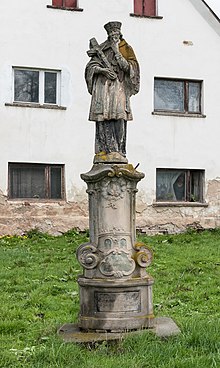Wojbórz
| Wojbórz | ||
|---|---|---|
 Help on coat of arms |
|
|
| Basic data | ||
| State : | Poland | |
| Voivodeship : | Lower Silesia | |
| Powiat : | Kłodzko | |
| Gmina : | Kłodzko | |
| Geographic location : | 50 ° 30 ′ N , 16 ° 39 ′ E | |
| Height : | 380 m npm | |
| Residents : | 1200 | |
| Telephone code : | (+48) 74 | |
| License plate : | DKL | |
| Economy and Transport | ||
| Next international airport : | Wroclaw Airport | |
Wojbórz (German: Gabersdorf ) is a village in the powiat Kłodzki in the Voivodeship of Lower Silesia . It is eight kilometers north of Kłodzko , to whose independent rural community it belongs.
geography
Wojbórz is located at the southwestern foot of the Warthagebirge ( Góry Bardzkie ). To the north rises the 667 m high Słup ( Hupprich ) mountain . Neighboring towns are Wilcza ( Wiltsch ) in the northeast, Opolnica ( Giersdorf ) and Morzyszów in the west, Młynów in the southeast, Ścinawica in the south, Łączna in the southwest, Bożków in the west and Czerwienczyce in the northeast.
history
Gabersdorf was mentioned for the first time in 1342 and referred to in old documents as Gebhardsdorf , Gebersdorf or, in Latin, Gebhardi villa . The St. The parish church consecrated to St. George dates back to 1349. Gabersdorf was the seat of the rulership of the same name and belonged to the Glatzer Land , with which it shared the history of its political and ecclesiastical affiliation from the beginning. In the old days it consisted of two parts:
The dominial share was initially a fiefdom and as such an ancestral property of the von Zischwitz family ( Tschischwitz, Czeschwicz ). The first owner known by name was Titz von Zischwitz auf Gebhardsdorf ( Gabersdorf ) and Albendorf in 1337 , whose descendants retained the dominion until 1625. In that year, Christoph, Abraham and Joachim von Zischwitz, who owned the dominion and the three manorial outbuildings in Gabersdorf, were expropriated by Emperor Ferdinand II in his capacity as King of Bohemia because of their participation in the Bohemian rebellion . Baron Urban von Pötting received their property in 1625, at whose request the Emperor transformed the fief into an inheritance in 1628. That same year, this earned allodial the imperial eunuch Glatzer Governor Rudolph Philipp of Liechtenstein-Kastelkorn . On the basis of a contract, in 1630 he exchanged his possessions in the County of Glatz with the imperial court councilor Johann Baptist Weber zu Pisemberg for his rule in Krumbach , located in Swabia . Johann Baptist Weber died in 1640, and the Gabersdorf rulership inherited his daughter Catharina, who was married to the imperial war councilor Ernst von Traun. In 1653 Catharina and Ernst von Traun sold their goods in Gabersdorf and Rothwaltersdorf to the imperial war councilor Heinrich Degner von Degenheim. After his death in 1668, the property was inherited by his son Johann Lorenz Degner von Degenheim, and then in 1688 by his daughter Anna Catharina, who had been married to Baron Stanislaus Philipp von Kurzbach since 1680 . They sold their inherited goods Gabersdorf, Rothwaltersdorf, Mühldorf, Morischau and Wiltsch to the Eckersdorfer landlord Johann Ernst von Götzen (1667–1707). After his grandson Johann Joseph von Götzen died childless in 1771, his property was first inherited by his three sisters and in 1780 by his nephew Anton Alexander von Magnis .
The Freirichtergut reached by different owners in 1477 to Christoph sibilant wit, whose descendants possessed it until the unification with the Domini Alan portion.
After the Silesian Wars , Gabersdorf and the County of Glatz came to Prussia in 1763 with the Peace of Hubertusburg . Around 1800 the villages Gabersdorf, Neuhof, Böhmischer Wald, Wiesau as well as parts of the estate in Mühldorf and Wiltsch belonged to the rule Gabersdorf . Evidence of this period includes: a parish church, a parsonage, a school building, three outbuildings, a stately home, two Kretschame , two flour mills, 32 farmers and 101 gardeners and cottagers . The 1090 inhabitants at that time included a baker, blacksmith, tailor, shoemaker, potter and wagner as well as two carpenters.
After the reorganization of Prussia, Gabersdorf belonged to the province of Silesia from 1815 and was incorporated into the district of Glatz from 1816–1945 .
As a result of the Second World War , Gabersdorf, like most of Silesia, was placed under Polish administration in 1945 and renamed Wojbórz . The German population was expelled in 1946. Some of the new residents were displaced from eastern Poland . 1975-1998 Wojbórz belonged to the Wałbrzych Voivodeship ( Waldenburg ).
Attractions
- The parish church of St. George ( Kościół Św. Jerzego ) was first mentioned in 1349 and rebuilt around 1733. The baroque interior is from the 2nd half of the 18th century.
- The churchyard is surrounded by a wall from 1733. In the vaulted passage there are two niches with figures of saints.
- The baroque rectory with a gable roof dates from the 1st half of the 18th century.
literature
- Joseph Kögler : The chronicles of the county Glatz . Revised by Dieter Pohl . Volume 3, ISBN 3-927830-15-1 , pp. 23-42.
- Dehio Handbook of Art Monuments in Poland, Silesia , Munich / Berlin 2005, ISBN 3-422-03109-X , pp. 1022-1023.





